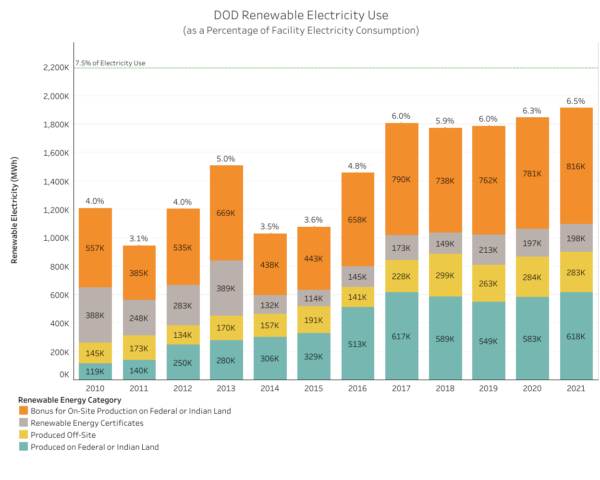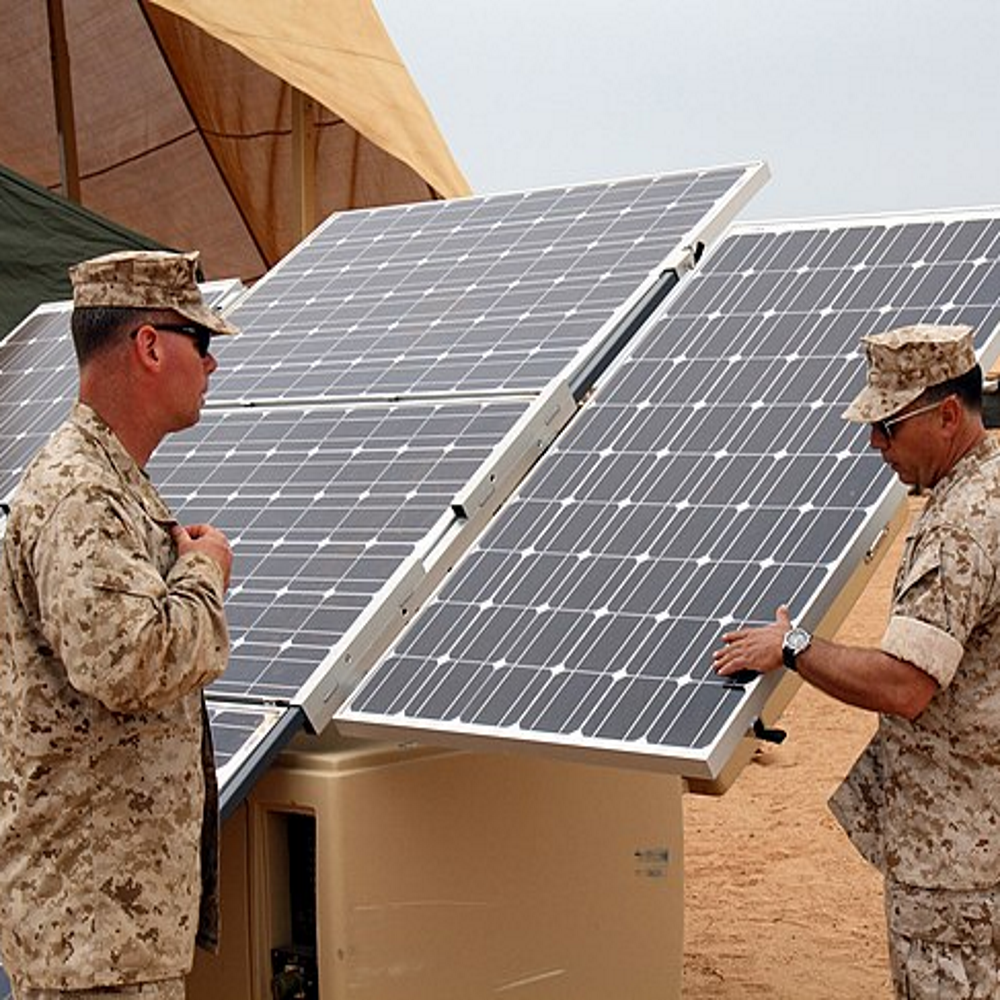The Department of Defense (DoD) is no stranger to the deleterious effects of climate change. The DoD notes that climate change has helped drive $13 billion in damages from natural disasters and extreme weather events to more than ten DoD bases from 2017 to 2021.
Notably, Air Force Base Tyndall in Florida suffered $4.7 billion in damages in 2018 from Hurricane Michael. The DoD estimates over 1,700 installations could be affected by sea-level rise. As a study from the U.S. Naval College noted in 1990, this threat goes beyond environmental changes to our oceans, coastlines, and temperatures, but offers risks to national security, and demands fundamental changes.
Adversaries of the U.S. may have already weaponized energy and the world’s dependence on fossil fuels. Russia’s recent attacks on Ukrainian energy infrastructure have exposed critical vulnerabilities that microgrids could prevent. Deploying renewable energy effectively lowers risks in the field of operations as well.
A 2009 report from Deloitte directly correlated this risk noting the “increasing number of convoys required to transport an ever-increasing requirement for fossil fuels is itself a root cause of casualties” due to the usage of explosive devices. The issue was further highlighted in 2019, when Iranian drones attacked Saudi oil facilities, knocking out 5% of the world’s oil supply, and causing a 20% spike in crude oil prices. As General James Mattis stated in 2003, the U.S. military needs to be “unleashed from the tether of fuel.”
Today that “tether” remains strong. The 2021 DoD Annual Energy Management and Resilience Report notes the “DoD is the largest single energy-consuming entity in the U.S., both within the federal government and as compared to any single private-sector entity,” and that “DoD operational and installation energy consumption represents approximately 76% of federal energy consumption,” 14 times higher than the next government agency, the postal service.
To curtail these massive emissions, the DoD has two federally mandated renewable energy goals. The DoD aims to reach 25% renewables by 2025. Under Section 203 of the Energy Policy Act, the DoD is forecast to consume at least 7.5% renewable energy as a percentage of total electricity consumption after 2013. These early goals have helped drive the adoption of renewables across all military branches. In 2021 the DoD reached an average production or procurement of 15.8% renewable energy, and consumption of 6.5% of total facility electricity consumption from renewables, or 1.92 GWh across 2,127 renewable energy projects.
As a result, in 2021 the DoD achieved a 30.1% reduction in greenhouse gas emissions from a 2008 baseline.

Image: Office of the Federal Chief Sustainability Officer
Recent changes signal a focused and structured effort than past federally mandated goals. In 2021, President Biden issued Executive Orders 14008 and 14057. EO 14008 requires that climate considerations “be an essential element of United States foreign policy and national security.” EO 14057 requires the “Federal government to lead by example in order to achieve a carbon pollution-free electricity sector by 2035 and net-zero emissions economy-wide by no later than 2050.” In 2022, each military branch published a climate strategy with actionable goals and objectives to enhance their respective forces and meet these new standards.
The Army Climate Strategy (ACS) is perhaps the most robust of these. The ACS identifies goals of a 50% reduction in the Army’s net GHG emissions by 2030, compared to 2005 levels, net zero Army GHG emissions by 2050, and an incorporation of the security implications of climate change into strategy, planning, acquisition, supply chain, and other processes. There are three “lines of effort” that link the necessary tasks with these goals.
The first line of effort targets installations with the strategic outcome being enhanced resilience and sustainability by adapting infrastructure. To accomplish this, the Army is aiming to install a microgrid on every installation by 2035 and to secure 100% carbon-pollution-free electricity for Army installations by 2030. Microgrids use solar or other local energy sources combined with energy storage to generate power for a building or group of buildings, enabling them to operate in “island mode” by disconnecting from the grid.
One of the Army’s resiliency goals is to install a microgrid on every installation by 2035. These will include renewable generation and large-scale battery storage, with the goal being able to “self-sustain its critical missions” on all Army installations by 2040. In addition, the Army aims to reduce greenhouse gas emissions by half from its buildings by 2032, compared to 2005. Part of the plan is for light-duty non-tactical vehicles to be all-electric by 2027, and all non-tactical vehicles would be electric by 2035.
In August 2022, the Biden administration announced the Climate Smart Building initiative, which aims to modernize federal buildings while cutting emissions. A $140 million infrastructure and energy resilience project at Joint Base McGuire-Dix-Lakehurst (JBMDL) in New Jersey is a part of that initiative and will include a 32 MW solar facility with a 2 MW/ 4 MWh battery energy storage system.
In addition to cutting emissions on military bases, the DoD is targeting acquisition and logistics to “increase operational capability while reducing sustainment demand and strengthening climate resilience.” This includes developing resilient supply chains and a clean procurement process. This will involve attaining net-zero GHG emissions from all Army procurements by 2050, which may catalyze defense contractors to make significant investments in renewable energy.
Another step involves the training of personnel in sustainability. For example, West Point recently announced a partnership to create a Sustainable Infrastructure, Resilience and Climate Consortium to “educate future Army leaders on how sustainability and resilience can increase the readiness of the force while simultaneously addressing the threats of climate change.”
Bipartisan solution
These goals are not empty promises, nor greenwashing to score political points. As the U.S. military is one of the biggest sources of emissions, its sustainability efforts will not only have a positive effect on the environment, but serve as an example of the potential of investing in clean energy.
The DoD is in the unique position of being able invest in sustainability efforts with significant bipartisan support. For example, the 2023 National Defense Authorization Act, passed in December with a vote of 83-11. The new bill includes $247 million in funding to improve energy on efficiency and mitigate logistics risk; $807 million is allocated for clean energy research and development; and another $2 billion allocated for climate resilience.
This content is protected by copyright and may not be reused. If you want to cooperate with us and would like to reuse some of our content, please contact: editors@pv-magazine.com.








By submitting this form you agree to pv magazine using your data for the purposes of publishing your comment.
Your personal data will only be disclosed or otherwise transmitted to third parties for the purposes of spam filtering or if this is necessary for technical maintenance of the website. Any other transfer to third parties will not take place unless this is justified on the basis of applicable data protection regulations or if pv magazine is legally obliged to do so.
You may revoke this consent at any time with effect for the future, in which case your personal data will be deleted immediately. Otherwise, your data will be deleted if pv magazine has processed your request or the purpose of data storage is fulfilled.
Further information on data privacy can be found in our Data Protection Policy.